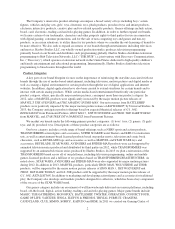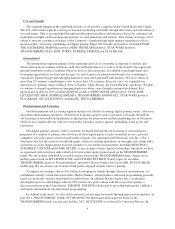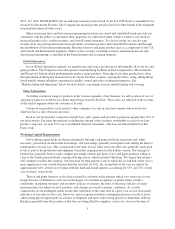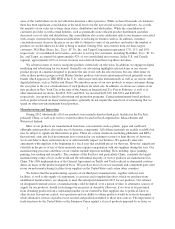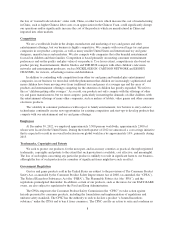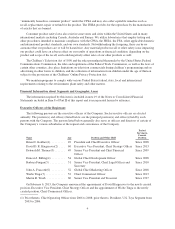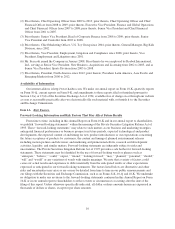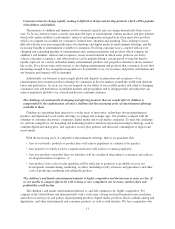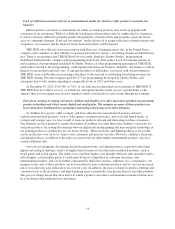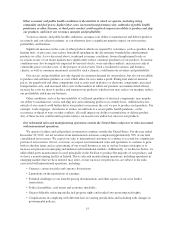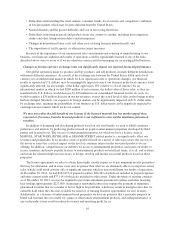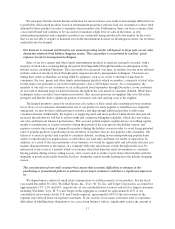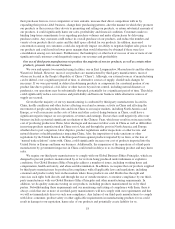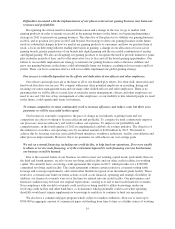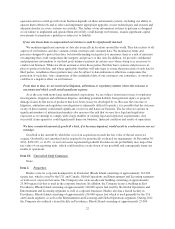Hasbro 2012 Annual Report Download - page 22
Download and view the complete annual report
Please find page 22 of the 2012 Hasbro annual report below. You can navigate through the pages in the report by either clicking on the pages listed below, or by using the keyword search tool below to find specific information within the annual report.are constantly monitoring and attempting to anticipate consumer tastes and trends, seeking ideas which will
appeal to consumers and introducing new products that compete with our products for consumer acceptance and
purchase.
In addition to existing competitors, the barriers to entry for new participants in the children’s and family
entertainment industry are low, and the increasing importance of digital media, and the heightened connection
between digital media and consumer interest, has further increased the ability for new participants to enter our
markets, and has broadened the array of companies we compete with. New participants with a popular product
idea or entertainment property can gain access to consumers and become a significant source of competition for
our products in a very short period of time. These existing and new competitors may be able to respond more
rapidly than us to changes in consumer preferences. Our competitors’ products may achieve greater market
acceptance than our products and potentially reduce demand for our products, lower our revenues and lower our
profitability.
An inability to develop and introduce planned new brands, products and product lines in a timely and cost-
effective manner may damage our business.
In developing new brands, products and product lines, we have anticipated dates for the associated product
introductions. When we state that we will introduce, or anticipate introducing, a particular product or product line
at a certain time in the future those expectations are based on completing the associated development,
implementation, and marketing work in accordance with our currently anticipated development schedule. There
is no guarantee that we will be able to manufacture, source and ship new or continuing products in a timely
manner and on a cost-effective basis to meet constantly changing consumer demands. This risk is heightened by
our customers’ compressed shipping schedules and the seasonality of our business. The risk is also exacerbated
by the increasing sophistication of many of the products we are designing, in terms of combining digital and
analog technologies, utilizing digital media to a greater degree, and providing greater innovation and product
differentiation. Unforeseen delays or difficulties in the development process, significant increases in the planned
cost of development, or changes in anticipated consumer demand for our products may cause the introduction
date for products to be later than anticipated or, in some situations, may cause a product introduction to be
discontinued.
United States, global and regional economic downturns that negatively impact the retail and credit markets,
or that otherwise damage the financial health of our retail customers and consumers, can harm our
business and financial performance.
We design, manufacture and market a wide variety of entertainment and consumer products worldwide
through sales to our retail customers and directly to consumers. Our financial performance is impacted by the
level of discretionary consumer spending in the markets in which we operate. Recessions, credit crises and other
economic downturns, or disruptions in credit markets, in the United States and in other markets in which our
products are marketed and sold can result in lower levels of economic activity, lower employment levels, less
consumer disposable income, and lower consumer confidence. Similarly, reductions in the value of key assets
held by consumers, such as their homes or stock market investments, can lower consumer confidence and
consumer spending power. Any of these factors can reduce the amount which consumers spend on the purchase
of our products. This in turn can reduce our revenues and harm our financial performance and profitability.
In addition to experiencing potentially lower revenues from our products during times of economic
difficulty, in an effort to maintain sales during such times we may need to reduce the price of our products,
increase our promotional spending and/or sales allowances, or take other steps to encourage retailer and
consumer purchase of our products. Those steps may lower our net revenues or increase our costs, thereby
decreasing our operating margins and lowering our profitability.
12


